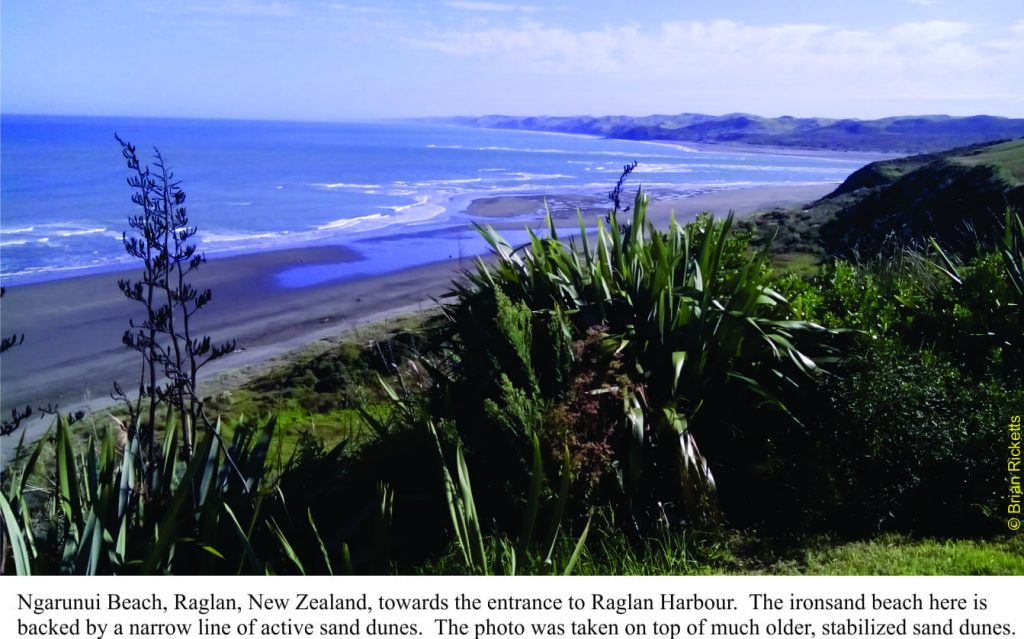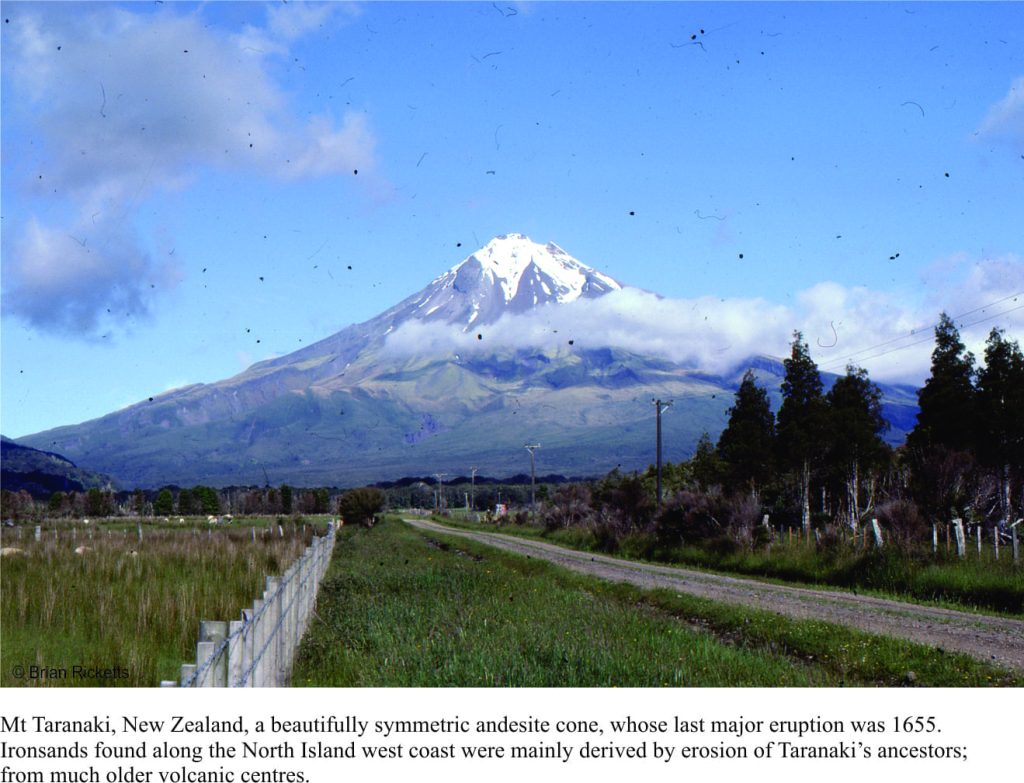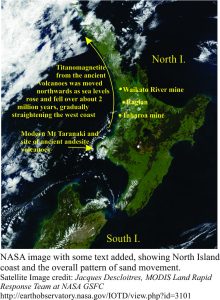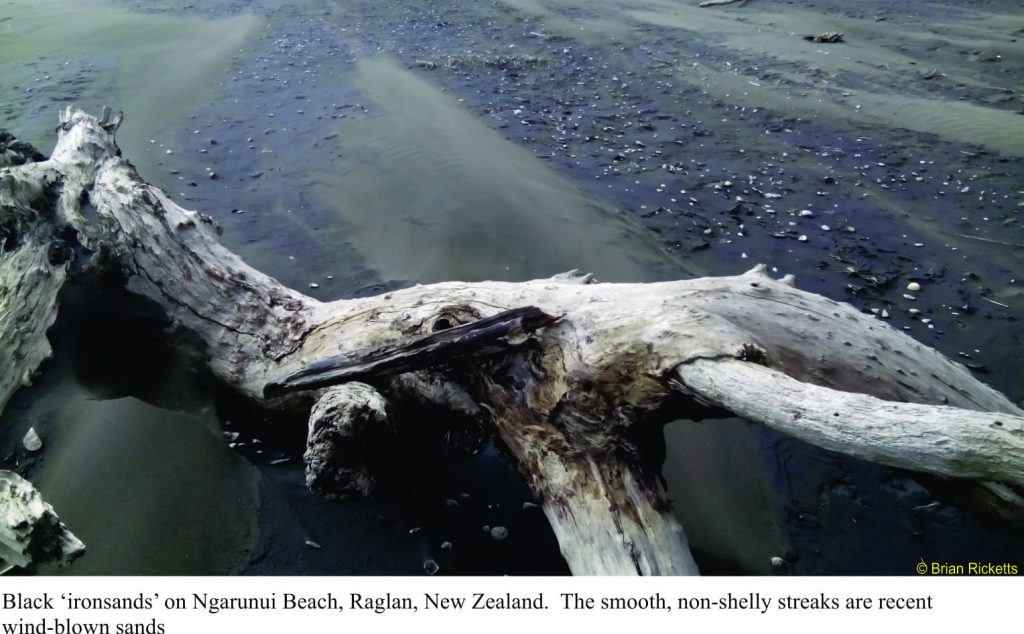February in New Zealand is mid-summer and this means beaches, swimming, BBQs, and generally chilling (often literally). One beach we frequent, a 50-minute drive, is Ngarunui. It is a popular surf beach near the coastal town of Raglan on New Zealand’s west coast. Here, the Tasman Sea rolls in, as it has done for millennia; the ancestral Tasman began to form about 80 million years ago, when the NZ subcontinent split from what then was a combined Australian – Antarctic continental block. The ‘Ditch’, as the Tasman is often called, is about 2000km wide so there is lots of space to develop a decent wave set.
Burned soles
 Ngarunui Beach, like many beaches up and down the North Island west coast, contains ‘black sand’. Actually it is more of a dirty grey colour, sometimes morphing to dark green hues. These are the ironsands, so called because of the preponderance of iron-bearing minerals. As far as beach sands go they can be a comfort and a curse; the former because they can be nice and warm after a swim in the pounding surf, and the latter because, if you forget your footwear, you can end up with 1st (common), 2nd (less common) and even 3rd degree burns to the soles of your feet. These sands can heat ferociously in the direct sun, but just as quickly can cool when the sun goes down. You can always tell when someone has forgotten their shoes; they run for the safety of wet sand or the nearest puddle. Dogs yelp.
Ngarunui Beach, like many beaches up and down the North Island west coast, contains ‘black sand’. Actually it is more of a dirty grey colour, sometimes morphing to dark green hues. These are the ironsands, so called because of the preponderance of iron-bearing minerals. As far as beach sands go they can be a comfort and a curse; the former because they can be nice and warm after a swim in the pounding surf, and the latter because, if you forget your footwear, you can end up with 1st (common), 2nd (less common) and even 3rd degree burns to the soles of your feet. These sands can heat ferociously in the direct sun, but just as quickly can cool when the sun goes down. You can always tell when someone has forgotten their shoes; they run for the safety of wet sand or the nearest puddle. Dogs yelp.
The boring part…
The iron in the ironsands is mostly present in the mineral titanomagnetite (chemical formula Fe3 (Ti)O4), which is basically magnetite (an iron oxide) with a bit of titanium (Ti) thrown in. The mineral, on its own has about 80% iron and 8-9% titanium. However, the ironsands also contain a few other dark, iron-bearing minerals (hornblendes that give the sands their greenish hue, and pyroxenes), plus lighter coloured quartz and feldspar. Overall, the sands contain from a few percent to 70% titanomagnetite grains. The sands occur in modern and old (up to 2 million years) sand dunes and coastal deposits. Transport and deposition of the sands by sea currents and winds produced large sand bars, or barriers that created the remarkably straight to slightly arcuate coastal profile along the west side of the North Island. Trying to work out where the titanomagnetite came from is an interesting forensic puzzle. We know which minerals are present in the ironsands and that the minerals must have come from some kind of rocky precursor (minerals like these don’t usually form in isolation). The investigation then searches for suitable rocky candidates. In this case, the minerals probably originated from ancient volcanoes about 180km south of Raglan, in Taranaki.
Erosion of the ancient volcanic edifices, built by andesite lava flows, produced huge volumes of sand and gravel that were moved by rivers to the ancient coast. This sediment gradually broke down to its constituent minerals, including grains of titanomagnetite, and were moved progressively northwards by sea currents and wind. The whole process took 10s to 100s of thousands of years. The ironsands are now found up to 400 km from their original source. However, we need to keep in mind that these sands did not travel in a straight line, but were moved seaward and shoreward many times during their journey north, in concert with sea levels that have fallen and risen several times over the past 2 million years. It is quite likely that large volumes of the ironsands have actually travelled several thousand kilometres to where we now see them.
Winnowing; separating the wheat from the chaff
The word winnowing is derived from the Old English windwian, from the wind. Geologists have borrowed it to describe an effect observed in sediment when it is moved by currents (wind or water). The process describes how sand grains of different density are separated as they move with the currents.
Erosion of the original Taranaki volcanic rocks would have produced grains of rock, feldspar as well as titanomagnetite. Titanomagnetite is very heavy; it is twice as dense as quartz and feldspar. Ocean and wind currents will preferentially move the lighter feldspar (and any quartz if present) and basically leave the titanomagnetite (and other heavy minerals) behind. In this way, the richest iron-bearing sands tend to be found closer to the original source in Taranaki whereas the proportion of ironsand 400 km away is significantly reduced.
Ironsand mining
The sands have been mined at two sites since 1970. At Taharoa (see map) they are excavated from ancient sand dunes and pumped as a slurry to a ship anchored 3 km offshore (there is no harbour there), where the product is exported. At a second site (Waikato River mouth) the mined sands are used for smelting at a local steel mill.
There have been applications to mine the ironsands from the west coast sea bed. There are clear environmental concerns with such an operation, especially as they relate to the sustainability of fisheries.





















1 thought on “Burnt soles: black sand beaches in New Zealand”
Pingback: click here